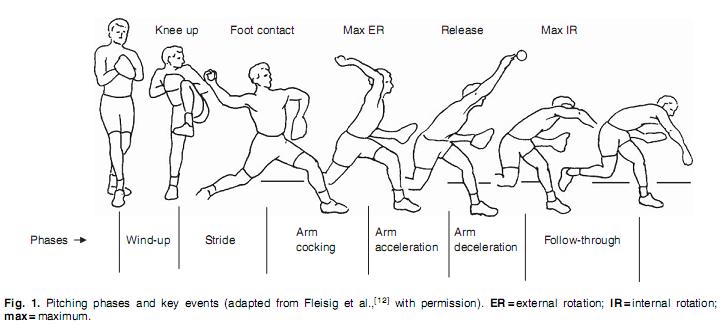PHYSIOSENSE PHYSIOTHERAPY LEICHHARDT
|
As we move into summer our sports tend to become a little more throwing orientated so I felt that it would be a good chance to consider a few factors predisposing the sports person to a throwing injury. I recently reviewed an excellent blog; https://mikereinold.com/gird-baseball-pitching-injury/ which prompted my review. It was really refreshing to see some experts describe that they were not better than everybody else at their assessments but that they have the opportunity to see many more throwing injuries and therefore have a better idea of what to consider. A small blog is not going to cover the many injuries of the upper limb that occur from throwing but hopefully it can give enough information to prompt a review when you think that you might be out of your depth. The review article (by Lenny Macrina)describes an internal rotation deficit being traditionally correlated with an increased incidence of shoulder injuries. This made me consider a seminar with a prominent Australian physio a few years ago who commented that he felt it was the total range of combined internal and external rotation that mattered more than just an internal rotation deficit. Indeed by the end of the article Lenny has largely drawn the same conclusions. So the overall consideration of the throwing athlete is much more than just a simple assessment of range. At the speed a hard throw is released our biomechanics have to be well aligned so that we do not cause increased stress on any of the body tissues related to this motion. Classically in Australia this most closely relates to our cricketing fast bowlers that seem to get small but debilitating injuries as they push themselves to their biomechanical limits. The body is just working on the edge of what is possible. So its not just about increased flexibility or range because this can quickly descend into laxity and injury. A further example is the consideration of external rotation. External rotation is often considered crucial in developing arm speed as it is important in the cocking motion of the throw and helps the thrower develop more speed as the arm moves into position to release the ball by forcefully internally rotating the shoulder. A blog by Tread Athletics :”Do you need 180+ degrees to throw harder? No”;describes that pro baseball pitchers in America tend to have between 160 to 185 degrees of external rotation so other factors must be considered in determining overall ball speed http://treadathletics.com/blog/external-rotation-throw-harder/. The Tread Athletics blog also develops some excellent training principles for consideration of the whole biomechanical chain, from lower body strengthening of the gluteals then back up to mobilising the thoracic spine. If you need any more convincing have a look at these “fun” facts from https://www.p2sportscare.com/shoulder-pain-pitching/ : Fun Facts on Shoulder Pain while Pitching Fact #1:13%: The percentage of the force generated by the shoulder when pitching. (9,10,11,26)Notice that this is not a large percentage at all. This means that much your velocity in pitching will does not come from the arm/shoulder. So then where does it come from? See the fact below to find out. Fact #2:51-55%: The percentage of force generated by the trunk, pelvis, and legs when pitching. (9,10,11,26)This percentage is huge! The power that your lower body produces is where most of your pitching velocity comes from. Great pitchers don’t just glide off the mound, they drive off the mound. By using your lower body more during pitches, you could just end up saving your shoulder and elbow from a lot of pain and frustration later on. Throwing is complex when you break it down, if your starting to get pain with this activity its probably times to see a physio for a proper clinical review. A few exercises to get you started:
Get your summer started right and don't just get out there and expect to start where you finished last season. Our bodies adapt quickly and you cant expect your throwing to be as strong if you haven’t continued this activity during the off season. The words and other content provided in this blog and in any linked materials, are not intended as medical advice and are an opinion only. If the reader or any other person has a medical concern you should consult a medical practitioner immediately. While Physiosense Physiotherapy have made every effort to ensure the information supplied on this web site is suitable, accurate and complete, we accept no responsibility for any loss or liability incurred by any party as a result of accessing or utilising the information on this website, blog or for any websites linked to or from this website. We try to ensure the information on this website is up-to-date and accurate, however we take no responsibility for inaccuracies or any information that is out of date.
Comments are closed.
|
AuthorJason is the Leichhardt Physiotherapy clinic practice principal. A graduate from Sydney Uni and practicing for over 20 years, he is passionate about sharing new discoveries. |
|
Find us at:
137 Catherine Street Leichhardt Sydney NSW 2040 |


 RSS Feed
RSS Feed